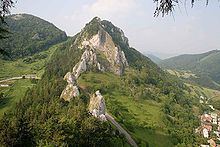 | ||
Pieniny klippen belt top 7 facts
The Pieniny Klippen Belt is in geology a tectonically and orographically remarkable zone in the Western Carpathians, with a very complex geological structure. It is a narrow (only 0.4 to 19 km) and extremely long (about 600 km) north banded zone of extreme shortening and sub-vertical strike-slip fault zone, with complex geological history, where only fragments of individual strata and facies are preserved. The Pieniny Klippen Belt is considered one of the main tectonic sutures of the Carpathians and forms the boundary between the Outer (externides a thin-skin thrustbelt) and Central Western Carpathians (internal thick-skin thrustbelt).
Contents
The Pieniny Klippen Belt emerges from beneath the Neogene sediments of the Vienna basin near Podbranč in western Slovakia and continues eastward to Poland, where it bends and returns to Slovakia in the area of Pieniny. The klippen belt then continues to Ukraine and ends in Romania. In some places it is covered with younger deposits, for example in the Podhale basin in Poland, or in the Vihorlat Mountains in Slovakia.
Klippes, which are the most characteristic features of the belt, are Jurassic to lower Cretaceous lenses - rigid blocks of limestone, tectonically separated from their unknown substratum. These blocks are also cropping out in tectonic windows in the overlying middle Cretaceous to Paleogene sediments. Strong tectonic deformation is a result of two main phases during the Alpine orogeny. The oldest phase is called the Laramide phase or Jarmuta phase and occurred in the Cretaceous and Paleogene periods. It caused thrusting of the nappes. The second phase is called the Savian or Helvetian phase. It was induced by subduction of the Northern Penninic ocean and caused the formation of the Carpathian Flysch Belt.
Geological structure
The Pieniny Klippen Belt is divided into numerous tectonic units, but only few of them occur throughout the entire belt. The oldest rocks of the Klippen belt are Middle Jurassic to upper Cretaceous. They are in normal stratigraphical positions, with only minor hiatus. Large scale crustal shortening caused rocks of different tectonic units and origin to be thrusted over each other and now lying juxtaposed. These tectonic units are:
- The Czorsztyn unit, named after Czorsztyn in Poland, is found in the most northern part of the Klippen Belt. It consists of shallow marine sediments, usually Jurassic nodular limestones and Cretaceous so called couches rouges marlstones.
- The Kysuca unit (also known as Kysuca-Pieniny unit). The Jurassic sediments of this unit are mostly deep marine in origin (typical radiolarites). Most of the other tectonic units were deposited between the shallow Czorsztyn and deep marine Kysuca unit.
- the Pruske unit (also known as the Niedzica or Czertezik unit) has a transitional facies between shallow and deep marine environments.
- The Klape unit composed of cretaceous turbiditic sediments containing exotic conglomerates with pebbles from an unknown source area. It is probably an acretionary wedge or some unknown terrane carried by the Fatric, but its origin is still a subject of discussion.
- Orava unit with typical limestones with unique ammonite fauna, typical klippes occur only in Orava region.
- The Manín unit contains typical Urgonian limestone. It has only partially a tectonic style of klippes, It is usually assigned to the Fatricum as well as the Drietoma and Haligovce units. Its origin is still disputed, because some geologists consider it a proximal part of the Tatric sedimentary cover.
The Czorsztyn unit has the shallowest marine facies. Together with smaller continental slope units and the deep marine Kysuca unit it forms a continental domain called the Oravicum, which is geometrically equivalent to the Briançonnais microcontinent in the Western and Central Alps.
Development
Reconstruction of the older phases of development is not possible because of absence of pre-triassic rocks. The development of Pieniny Klippen Belt started on passive margin of European platform in Lower Jurassic with rifting and tectonic subsidence of Oravic unit. During the Middle Jurassic to Lowermost Cretaceous an elevated continental ribbon called the Czorsztyn Ridge evolved due to the thermal uplift and continental break-up at the southern side of the Czorsztyn Ridge. Rifting resulted in the opening of basinal area called the Kysuca basin or Vahic Ocean (South Penninic or Piemont ocean equivalent) to the south of the Oravic area. In the Upper Jurassic entire Oravic domain began to thermally subside. Since Lowermost Cretaceous time probably an asymmetrical rifting affected the area to the North of the Czorsztyn Ridge where a Magura basin (North Penninic or Valais Ocean equivalent) started to evolve.
During the Middle Cretaceous thermal subsidence of the Czorsztyn Ridge caused it development into a pelagic high. In Turonian times frontal elements of the Fatric Nappe System of the Inner Western Carpathians were emplaced onto the southern parts of the Vahic Ocean. In the Upper Cretaceous to Paleocene the Vahic Ocean began to close. The Oravic units were detached from its subducting basement and formed a fold and thrust belt. After first phase of folding and thrusting sedimentation of turbiditic sequences was restored. Whole area was again deformed in second phase of orogeny in the Upper Paleogene to Lower Miocene when sinistral transpression and amalgamation with hinterland part of closed Magura Ocean caused formation of typical "klippen" tectonic style due to counterclockwise rotation of ALCAPA microplate. During this times several subduction related calc-alcaline volcanoes locally evolved in the area. Later sinistral transtension and lateral extension modified the structure of the belt during the Late Miocene and Pliocene. Extensional deformation on the eastern and western edge of the belt interacted with development of the Vienna and Transcarpathian basin. After the marine regression at the end of Miocene younger marls and turbidites were eroded faster than more competent Jurassic limestones forming distinctly looking klippes.
